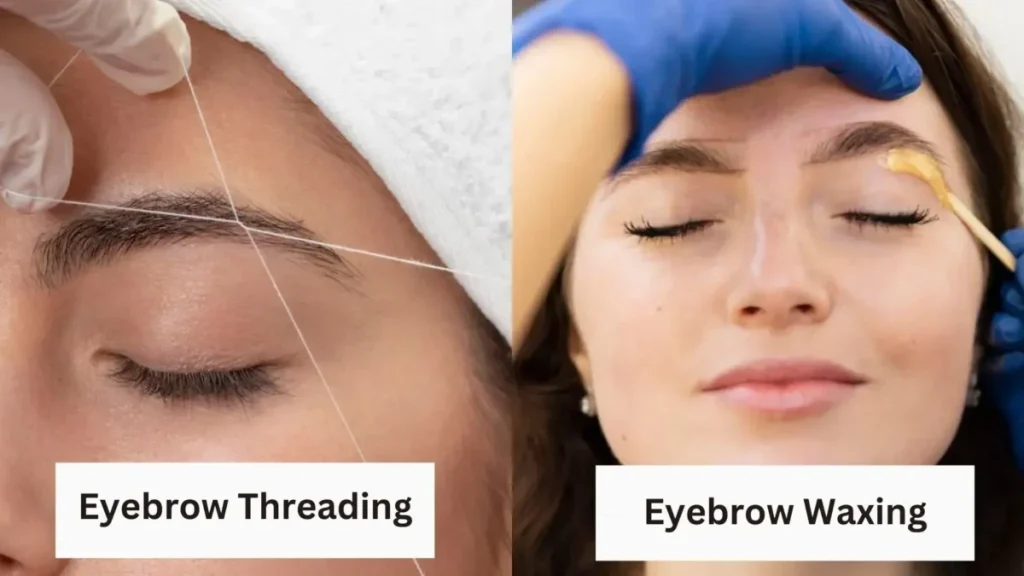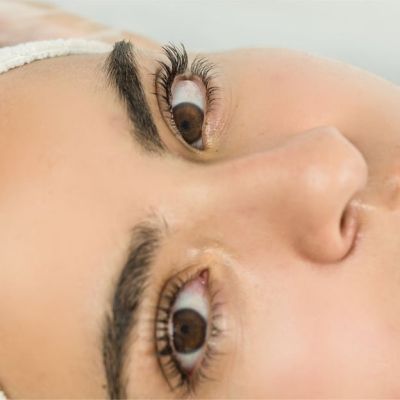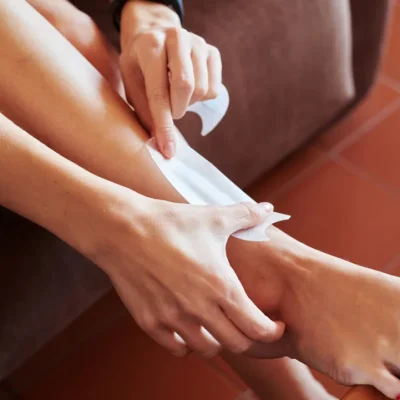When it comes to eyebrow grooming, two of the most popular methods are threading and waxing. Each technique has its own advantages and disadvantages, and choosing the right one depends on individual preferences, skin type, and desired results. In this blog post, Diva Salon delves to the differences between eyebrow threading and waxing, examining their techniques, benefits, drawbacks, and suitability for different skin types.
The Technique of Eyebrow Threading

Eyebrow threading is an ancient hair removal technique that originated in Asia and the Middle East. This method uses a thin, twisted cotton thread that is rolled over unwanted hair, plucking it out at the follicle level. The technician holds one end of the thread in their mouth or in their hand and the other end in the opposite hand, creating a loop that is moved across the skin to trap and pull out hair. Threading is known for its precision, making it ideal for shaping eyebrows with a clean, defined look.
The Technique of Eyebrow Waxing
Eyebrow waxing involves applying a thin layer of wax to the skin, which adheres to both the hair and the skin. A cloth or paper strip is then pressed onto the wax and quickly pulled off in the opposite direction of hair growth, removing the hair from the root. There are two main types of wax used in eyebrow waxing: soft wax (strip wax) and hard wax (stripless wax). Soft wax is more commonly used for larger areas, while hard wax is gentler and preferred for sensitive skin and smaller areas like the eyebrows.
Eyebrow waxing is a precise technique used to shape and define eyebrows by removing unwanted hair from the root. This method offers a clean, well-groomed look that lasts longer than traditional shaving or tweezing. Waxing helps achieve a symmetrical shape, ideal for those seeking a polished appearance. The process involves applying warm wax to the brow area, followed by a quick strip removal. For professional results and personalized eyebrow shaping, consider scheduling an appointment with a specialized eyebrows service.
Precision and Control
One of the main differences between threading and waxing is the level of precision and control each method offers. Threading is renowned for its accuracy, allowing for the removal of even the finest hairs and creating a well-defined eyebrow shape. The technician can target specific hairs, ensuring that the natural eyebrow shape is maintained and only unwanted hair is removed. In contrast, waxing removes larger sections of hair in one go, which can make it harder to achieve the same level of precision. This can be a drawback for those who desire a very specific eyebrow shape or have thin or sparse eyebrows.
Pain and Discomfort
Pain tolerance is a significant factor when deciding between threading and waxing. Threading is often described as feeling like a series of quick pinches or stings, which can be uncomfortable but is generally tolerable. The sensation is more localized and immediate, and any discomfort usually subsides quickly after the session. Waxing, on the other hand, can be more painful, especially for those with sensitive skin. The act of ripping off the wax strip can cause a sharp, intense pain that can linger for a few minutes. Additionally, waxing can sometimes cause skin irritation or redness, which may last for several hours.
Skin Sensitivity and Reactions
Individuals with sensitive skin must consider how each hair removal method will affect them. Threading is often recommended for sensitive skin because it does not involve any chemicals or heat, reducing the risk of irritation, allergic reactions, or burns. However, threading can cause minor redness and swelling, especially if the skin is not held taut during the procedure. Waxing, while effective, can be harsh on sensitive skin due to the adhesive nature of the wax and the force required to remove it. This can lead to redness, swelling, and in some cases, small breakouts or ingrown hairs.
Duration of Results
Both threading and waxing provide longer-lasting results compared to other hair removal methods like tweezing or shaving. Threading typically keeps eyebrows hair-free for about two to four weeks, depending on individual hair growth rates. Waxing results can last slightly longer, ranging from three to six weeks, as it removes hair from the root and can also weaken the hair follicle over time. This means that with regular waxing, hair growth may become finer and sparser, potentially extending the time between sessions.
Cost Comparison
The cost of eyebrow threading and waxing can vary depending on location, salon, and the experience of the technician. Threading is typically more affordable, with prices ranging from $10 to $25 per session. Waxing can be slightly more expensive, with prices ranging from $15 to $35 per session. While the difference in cost may not be significant for some, it can add up over time, especially for those who require frequent maintenance. Additionally, the price may vary based on the type of wax used and any additional services or products offered during the session.
Cost comparison for beauty treatments often reveals significant variations depending on location and service. In Doha, eyebrow threading costs can range from 30 to 70 QAR, influenced by the salon’s reputation and expertise of the technician. Comparing these rates with other beauty services helps in understanding overall expenses. To get the best value, consider both price and quality when choosing your threading service.
Hygiene and Safety
Hygiene is an important consideration for any hair removal method. Threading is often viewed as more hygienic because it does not involve direct contact with the skin. The thread is used once and then discarded, reducing the risk of cross-contamination or infection. However, it is crucial to ensure that the threading practitioner uses a new, clean thread for each client. Waxing, on the other hand, involves direct contact with the skin and the use of wax that is heated and applied with sticks or spatulas. It is essential to ensure that the salon follows strict hygiene protocols, such as not double-dipping applicators into the wax pot and using clean strips for each client, to prevent infections or skin irritations.
Suitability for Different Skin Types
Threading is generally suitable for all skin types, including sensitive and acne-prone skin, because it does not involve chemicals or heat. It is also a good option for those with very fine or thin hair that may not be effectively removed by waxing. Waxing is suitable for most skin types but may not be ideal for extremely sensitive or reactive skin. Those with conditions like rosacea, eczema, or psoriasis may find waxing too harsh and may prefer threading instead. It is always advisable to consult with a professional to determine the best method for your specific skin type and condition.
Impact on Hair Growth
Both threading and waxing remove hair from the root, which can lead to slower and finer hair regrowth over time. However, repeated waxing sessions can weaken the hair follicle, potentially leading to less dense hair growth in the treated area. Threading does not have the same weakening effect on hair follicles, so hair may grow back at its usual rate and thickness. For those looking to reduce the overall thickness and density of their eyebrow hair, waxing may be the preferred method. Conversely, for those who do not want to alter the natural growth pattern of their eyebrows, threading may be a better choice.
The impact on hair growth can be influenced by various factors including genetics, diet, and overall health. Nutrient deficiencies, hormonal imbalances, and stress can hinder hair growth or lead to thinning. Proper hair services, such as regular trims, scalp treatments, and professional advice on hair health, can play a crucial role in promoting healthy hair growth. Consulting with hair services ensures you address underlying issues and implement effective strategies tailored to your specific needs.
Post-Treatment Care
Proper aftercare is essential to maintain the results of both threading and waxing and to prevent any adverse reactions. After threading, it is recommended to avoid touching the treated area, applying makeup, or exposing it to direct sunlight for a few hours to prevent irritation or infection. Applying a soothing gel or aloe vera can help reduce any redness or swelling. After waxing, similar precautions should be taken, along with avoiding hot showers, saunas, or any activities that cause excessive sweating for at least 24 hours to prevent irritation. Using a gentle exfoliator a few days after waxing can help prevent ingrown hairs and maintain smooth skin.
Frequency of Maintenance
The frequency of maintenance for threading and waxing depends on individual hair growth rates and personal preferences. Threading typically requires more frequent sessions, about every two to four weeks, as it removes hair at the surface level and does not weaken the hair follicle. Waxing, due to its potential to slow down hair regrowth, can be done every three to six weeks. Some individuals may prefer the more frequent maintenance of threading to keep their eyebrows looking consistently sharp, while others may appreciate the longer-lasting results of waxing and the reduced frequency of sessions.
Environmental and Ethical Considerations
For those concerned about environmental and ethical factors, threading may be the more sustainable option. It requires minimal tools and produces very little waste, as the thread is biodegradable and does not involve disposable strips or applicators. Waxing, on the other hand, generates more waste due to the use of disposable strips, applicators, and the packaging of wax products. Additionally, some waxing products may contain synthetic ingredients or be tested on animals, which may be a concern for ethically conscious consumers. Opting for eco-friendly, cruelty-free waxing products can mitigate some of these concerns.
Personal Preferences and Lifestyle
Ultimately, the choice between eyebrow threading and waxing comes down to personal preference and lifestyle. Some individuals prefer the precision and control offered by threading, while others appreciate the thoroughness and longer-lasting results of waxing. Those with busy schedules may opt for the convenience of threading, while those who prefer less frequent maintenance may choose waxing. It is important to consider factors such as pain tolerance, skin type, cost, and desired results when making a decision.
FAQs
Which is better for eyebrows, waxing or threading?
Eyebrow waxing can last anywhere from 3-6 weeks, while threading lasts 2-5 weeks, so waxing your eyebrows would have longer-lasting results. However, the longevity of the results is pretty close in hand, and depending on your hair growth pattern, the amount of time both will last could be pretty equal for some people.
What are the disadvantages of eyebrow threading?
You can also expect some redness, irritation and, potentially, even moderate swelling in the hours after the procedure. As with waxing and plucking, your skin could break out and — while the risk of infection is low — it does exist.
Is eyebrow threading more expensive than waxing?
Waxing, microblading, and tweezing are all tried-and-true hair removal methods. However, eyebrow threading is a cost-effective alternative that’s equally good at shaping your brows. Plus, it’s much gentler and less painful than other options like waxing or plucking.
Which is better full face threading or waxing?
Hair type and thickness: Threading provides precise control and is ideal for fine to medium hair. Waxing can effectively remove hair of various thicknesses but may not be as accurate as threading. Shaving suits all hair types but may not provide as smooth or long-lasting results as the other methods.
Does eyebrow threading increase hair growth?
Threading slows down and reduces hair growth. hair also grows much thinner thus making it easier to remove and less painful when threaded. Tweezing just one time in between will reverse all that is achieved from threading and can further irritate follicles which can cause hair to become ingrown, coarser, and darker.
Conclusion
Both eyebrow threading and waxing are effective methods for achieving well-groomed eyebrows. Each technique has its own set of advantages and disadvantages, making it essential to consider individual preferences and needs. Threading offers precision and is gentle on sensitive skin, while waxing provides longer-lasting results and can reduce hair density over time. By understanding the differences between these methods, individuals can make an informed choice that best suits their lifestyle and aesthetic goals. Whether you opt for threading or waxing, maintaining proper aftercare and hygiene practices is crucial for achieving the best results and keeping your eyebrows looking their best.




